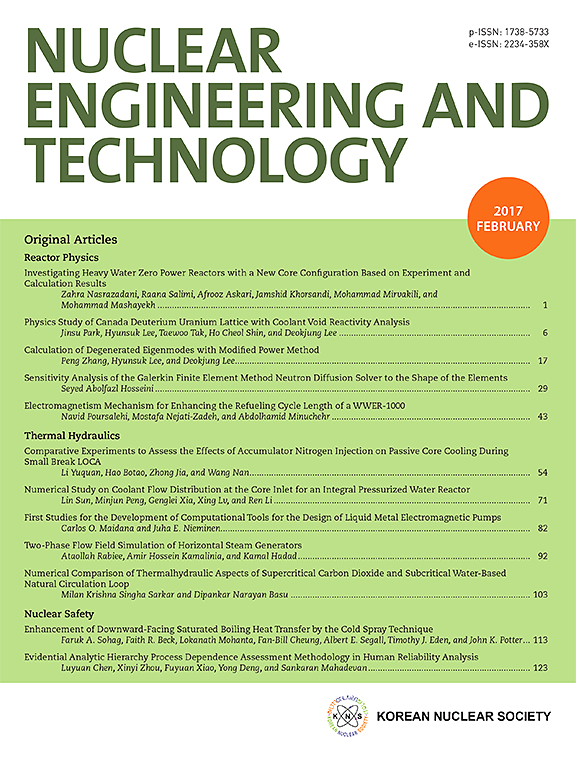ATF燃料低浓铀临界计算的可行性研究
IF 2.6
3区 工程技术
Q1 NUCLEAR SCIENCE & TECHNOLOGY
引用次数: 0
摘要
本研究使用SCALE 6.3.1的CSAS6/KENO-VI模块评估了APR-1400乏燃料池(1区)和新燃料储存库(NFSV)中容故性燃料(ATF)和低浓铀+ (5-10 wt% U-235)的临界安全性。经证实,仅仅将燃料浓缩度提高到5%以上就会显著提高临界风险。为了解决这一风险,中子吸收板应该添加到现有的存储架上。通过添加吸收剂,ATF在1区富集高达8 wt%,在NFSV中富集10 wt%,保持安全的亚临界状态。为了符合美国核管理委员会的指导方针,必须对吸收剂进行修改,特别是考虑到硼的面密度和通量阱特性。因此,虽然较高的富集度会增加临界风险,但适当的吸收板设计可以确保足够的安全裕度。这些发现预计将有助于设计和操作未来采用低浓铀+和ATF的储存设施。本文章由计算机程序翻译,如有差异,请以英文原文为准。
Feasibility study for the criticality calculations of the LEU+ with ATF fuels
This study evaluates the criticality safety of Accident Tolerant Fuel (ATF) and LEU+ (5–10 wt% U-235) in the APR-1400 spent fuel pool (Region 1) and new fuel storage vault (NFSV) using SCALE 6.3.1's CSAS6/KENO-VI module. It was confirmed that simply increasing fuel enrichment above 5 wt% significantly raises criticality risk. To solve this risk, neutron absorber plates should be added to existing storage racks. By adding absorbers, ATF enriched up to 8 wt% in Region 1 and 10 wt% in the NFSV remained safely subcritical. Compliance with NRC guidelines necessitates such absorber modifications, especially considering boron areal density, flux trap characteristics. Consequently, although higher enrichment elevates criticality risks, the proper design of absorber plates can ensure sufficient safety margins. These findings are expected to aid in designing and operating storage facilities for future adoption of LEU+ and ATF.
求助全文
通过发布文献求助,成功后即可免费获取论文全文。
去求助
来源期刊

Nuclear Engineering and Technology
工程技术-核科学技术
CiteScore
4.80
自引率
7.40%
发文量
431
审稿时长
3.5 months
期刊介绍:
Nuclear Engineering and Technology (NET), an international journal of the Korean Nuclear Society (KNS), publishes peer-reviewed papers on original research, ideas and developments in all areas of the field of nuclear science and technology. NET bimonthly publishes original articles, reviews, and technical notes. The journal is listed in the Science Citation Index Expanded (SCIE) of Thomson Reuters.
NET covers all fields for peaceful utilization of nuclear energy and radiation as follows:
1) Reactor Physics
2) Thermal Hydraulics
3) Nuclear Safety
4) Nuclear I&C
5) Nuclear Physics, Fusion, and Laser Technology
6) Nuclear Fuel Cycle and Radioactive Waste Management
7) Nuclear Fuel and Reactor Materials
8) Radiation Application
9) Radiation Protection
10) Nuclear Structural Analysis and Plant Management & Maintenance
11) Nuclear Policy, Economics, and Human Resource Development
 求助内容:
求助内容: 应助结果提醒方式:
应助结果提醒方式:


